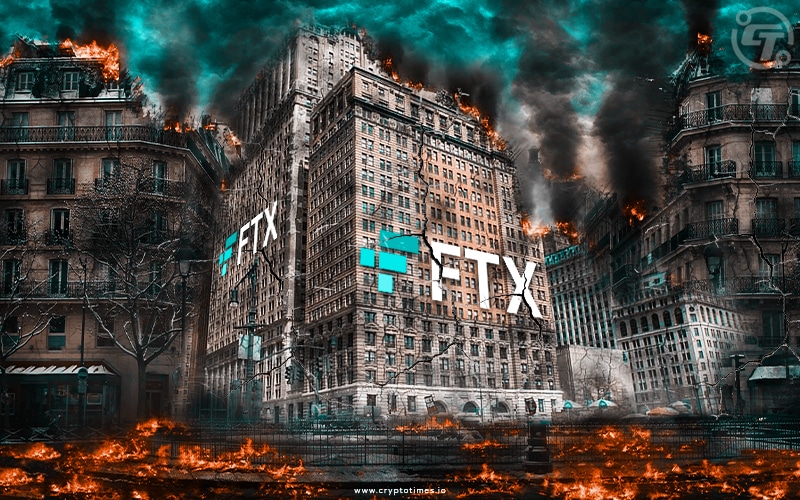The empire Sam Bankman Fried aka SBF established is crashing alongside cryptocurrency exchange FTX having gone from being one of the biggest cryptocurrency exchanges in the world to now being bankrupt.
It all began with a report on the inconsistent market cap of FTT and the illiquid FTT (FTX native token) holdings of Alameda Research, SBF’s crypto trading firm.
As soon as the news hit the internet, it sparked an uproar. The FTX’s ‘liquidity crunch’ was embroiled in controversy while a billionaire ‘once hailed as the savior of crypto’ lost all his riches. The FTX crash sent the entire crypto market into a tailspin, with Bitcoin and Ethereum prices plummeting when at the same time last year, Bitcoin was trading at an all-time high of $69.
Let’s explore the specifics of FTX’s situation and how it crashed. We must now closely monitor what the long-term effects of the FTX fall will be, considering the crypto sector has not yet fully recovered from the Terra Luna crash.
How did FTX Crash?
A lot of blame game has been going around on how the FTX crash was initiated. It all started when reports revealed that FTX CEO Sam Bankman-Fried’s crypto trading firm Alameda Research’s assets are reportedly held in illiquid altcoins, and FTXs native token FTT makes up the majority of its financial sheet.
The assets of Alameda Research totaled $14.6 billion, $3.66 billion of which was made up of unlocked FTT. The third-largest entry on the assets side of the accounting ledger was $2.16 billion in FTT collateral.
While these reports were spread like wildfire causing FUD, an unknown wallet transferred 30 million FTT tokens worth roughly $584.8 million to a Binance exchange wallet.
Later that day, Binance CEO CZ shocked the community by announcing it’s going to liquidate FTT tokens it received from the FTX last year as part of Binance’s exit from FTX equity.
This triggered the FTX crash that no one ever expected. CZ later confirmed that the transfer of 30 million FTT tokens was part of the liquidation.
“Due to recent revelations that have come to light, we have decided to liquidate any remaining FTT on our books,” CZ tweeted.
Binance apparently received roughly $2.1 billion equivalent in cash in the form of BUSD and FTT tokens.
An unknown wallet earlier that day transferred 30 million FTT tokens worth roughly $584.8 million to a Binance exchange wallet, which Binance CEO CZ later confirmed as part of the liquidation of the tokens.
This caused massive dumping of FTT tokens, and the community started panicking as they withdrew their assets from FTX, expecting a Terra Luna situation again.
FTX saw approximately $6 billion in withdrawals in 72 hours and more panic ensued.
Earlier reports came in that the majority of Sam Bankman-Fried’s trading firm Alameda Research’s assets are reportedly held in illiquid altcoins, and FTT makes up the majority of its financial sheet.
The assets of Alameda totaled $14.6 billion, $3.66 billion of which was made up of unlocked FTT. The third-largest entry on the assets side of the accounting ledger was $2.16 billion in FTT collateral.
SBF indirectly accused CZ by tweeting “A competitor is trying to go after us with false rumors. FTX is fine. Assets are fine.”
CZ responded to the ongoing FUD by tweeting “Liquidating our FTT is just post-exit risk management, learning from LUNA.”
Maybe CZ was hinting at SBF when he mentioned that he wouldn’t support lobbying against other industry players behind their backs. Things started spiraling, and within a few hours, the crypto community witnessed the slow collapse of the FTX exchange and FTT token.
Things started turning around when FTX CEO SBF tweeted, “Things have come full circle, and FTX.com’s first, and last, investors are the same: we have come to an agreement on a strategic transaction with Binance for FTX.com (pending DD, etc.).”
Binance signed a non-binding LOI, intending to fully acquire FTX and help cover the liquidity crunch that the latter is facing.
SBF asserted that customers are protected and he thanked CZ, Binance, and all FTX supporters for their assistance.
But Binance remained helpless in the FTX crash. As a result, it abandoned its planned acquisition of the FTX exchange.
CZ claimed that following a conversation with Sam Bankman-Fried, he had notified Binance to halt sales of FTT and instructed the employees not to trade FTT tokens.
Sam Bankman-Fried and his Favorite Alameda
Sam Bankman-Fried co-founded Alameda Research, a crypto trading business that served as the foundation for his future cryptocurrency empire, in late 2017.
As prosecutors and authorities look into the FTX crash, the link between Alameda and his crypto exchange, FTX, and how the two backed one another, is now under inspection.
SBF established FTX in 2019 in large part because of Alameda’s requirement for capital to operate its trading operation. However, due to the way the two organizations were set up when one unit experienced problems, it had an impact on the other.
To start trading, FTX called its native token FTT to move on with the trading and asked for seed capital from investors. Alameda operated as the token’s primary market maker in order to preserve the value of FTT and maintain its price stability.
That indicated that it traded the majority of FTT on the exchange and, as a significant trader, had the power to determine the token’s price.
The token’s increasing value helped both FTX and Alameda. The exchange started leveraging FTT to invest billions of dollars in numerous other cryptocurrency businesses.
Alameda Research and FTX’s native token FTT were ultimately found to be the primary responsible parties for the FTX crash.
Also Read: Why is FTX’s FTT Token crashing down?
Alameda was able to weather the Terra fall whereas crypto lenders like Three Arrows Capital and Celsius struggled to do so. However, it appears that the company’s problems began to develop already in the second quarter.
FTX may have fled out of Alameda during the crypto pandemic. On September 28, when 173 million FTT tokens were generated through a 2019 contract with Alameda as the beneficiary, the supply of the FTT market cap jumped by 124.3%, according to on-chain data.
After that, Alameda transmitted the entire freshly created FTT back to an FTX address, which prompted many people to think it was a debt refund. Then, there were numerous rumors that FTX used unreleased FTT as collateral to bail out Alameda.
But SBF and FTX along with Alameda were playing the ultimate saviors during the after-effects of the infamous Terra Luna crash and were on the front lines trying to save companies who got affected by the same.
After a while, the Texas State Securities Board started investigating both SBF and FTX US. They were accused of offering unregistered securities products in the U.S. through the yield-bearing service.
SBF did have his eye on politics and stated he could spend up to $1 billion or more in the 2024 elections. He even donated $50M in the upcoming midterm elections and this caused a commotion in the community.
SBF supported the CFTC-proposed Digital Commodities Consumer Protection Act (DCCPA) bill and was accused of quietly lobbying to get the bill passed which gives the CFTC power to kill DeFi but benefits FTX, thus inviting more criticism from the crypto community.
For Sam, the public backlash was severe as people’s attitudes changed as they realized that his motives might not be what they initially believed.
What is happening with FTX right now?
While SBF pretended that user assets are fine and FTX US is unaffected by all this, the thing that the whole community expected occurred. FTX filed for bankruptcy following the crash!!
FTX Group entities, which include the FTX.com entity as well as FTX US, Alameda Research, and “approximately 130 additional affiliated companies,” filed for Chapter 11 bankruptcy proceedings.
According to the bankruptcy filings, FTX has assets between $10 billion and $50 billion and liabilities between $10 billion and $50 billion.
CEO and founder SBF resigned from his role but will assist in an orderly transition. John Ray III is appointed as the new CEO.
FTX’s current CEO, John Ray, who assisted Enron through its corporate bankruptcy procedure in the early 2000s, claimed in a court filing that it is challenging to determine how and why the company’s money was managed in the manner they were.
That’s because it’s been claimed that FTX and its related companies violated accepted standards for financial reporting.
According to the bankruptcy documents, Bankman-Fried’s company’s balance sheets were never audited, thus there is no solid record or paper trail of the money the corporation had and where it went.
Ray stated the corporation has only so far recovered a fraction of the $740 million in crypto held by the many businesses that made up FTX and Alameda.
“Never in my career have I seen such a complete failure of corporate controls and such a complete absence of trustworthy financial information as occurred here,” Ray added.
Ray called bankruptcy the beginning of a path forward. He noted, “The immediate relief of Chapter 11 is appropriate to provide the FTX Group the opportunity to assess its situation and develop a process to maximize recoveries for stakeholders.”
FTX Digital Markets, FTX Australia, FTX Express Pay, and LedgerX (which does business as FTX US Derivatives) are not included in the bankruptcy proceedings, as per the filing.
SBF apologized by tweeting, “hopefully things can find a way to recover.”
The Aftermath of the FTX Crash
A hacker suddenly struck the beleaguered FTX exchange following its crash. FTX reportedly suffered a hack with more than $600 million drained from FTX’s crypto wallets.
While discussions were going on about the whole FTX situation, FTX account holders started reporting that their assets had disappeared from their wallets, sparking rumors of a potential hack.
FTX exchange’s Telegram group admin later confirmed the hack warning the users, “FTX apps are malware. Delete them… Don’t go on the FTX site as it might download Trojans.”
Of these drained-out funds, $477 million is thought to have been looted, and the remaining funds are deemed to have been transferred by FTX to secure cold storage.
FTX US general counsel Ryne Miller supports the hypothesis that the transactions were made to safeguard the funds still in FTX’s wallets. He confirmed that the process was expedited to mitigate damage upon observing unauthorized transactions.
Crypto exchanges including Binance, KuCoin, and others have delisted FTX’s native token, FTT, from their platforms as a result of price volatility caused by the FTX liquidity crisis.
Who Got Affected in the FTX Crash?
FTX investors are having a hard time since the liquidity issues of FTX got uncovered. The seven-time Super Bowl champion Tom Brady and his ex-wife, Gisele Bündchen were brand ambassadors and advisers of FTX. It’s not yet known how much they lost in their deal with FTX.
Along with Tom Brady, more FTX ambassadors like sports stars Steph Curry, Shohei Ohtani, and Naomi Osaka have an equity stake in the FTX as part of their partnership.
FTXs’ partnership with sports organizations such as Major League Baseball, Monumental Sports & Entertainment, Golden State Warriors, Mercedes Formula One, and TSM remains uncertain.
Crypto lender BlockFi couldn’t catch a break since Celsius and 3AC collapsed. As of now BlockFi paused client withdrawals and limited platform activity following the crash of the crypto exchange FTX and is now in preparation to file for bankruptcy.
Venture capital firm Sequoia Capital doesn’t want to be related to the FTX exchange either. It didn’t delay in marking down its investment in the collapsing exchange from $213.5 million to $0.
Galaxy Digital disclosed that it has exposure to FTX totals more than $76 million. Cash and digital assets are both included in the $76.8 million.
Solana lost 61.6% of its value in the last seven days, and its price is now down 95% from its all-time high of Nov. 6, 2021. The full extent of the Solana Foundation’s funding connections to FTX and Alameda Research has now been made public and there are roughly 3.43 million FTT tokens and 134.54 million SRM tokens that have been left over in the exchange.
FTX Sparks Regulatory Response
California’s Department of Financial Protection and Innovation (DFPI) announced it is looking into FTX after the platform for crypto assets abruptly crashed.
The assets of FTX Digital Markets “and associated parties” have now been blocked by the Bahamas Securities Commission in response to SBF’s announcement that he is closing Alameda Research.
Sam Bankman-Fried is also being investigated by the US Securities and Exchange Commission and DOJ for possible securities law violations.
The Royal Bahamas police said a team of financial investigators is working closely with the Bahamas Securities Commission following the FTXs crash globally and the provisional liquidation of FTX Digital Markets Ltd.
The Bahamas Supreme Court has approved two insolvency experts: Messrs. Kevin Cambridge and Peter Greaves at PricewaterhouseCoopers (PwC) as provisional liquidators of bankrupt FTX.
The Australian Securities and Investments Commission suspended FTX Australia Pty Ltd’s Australian financial services license until 15 May 2023, following the firm’s voluntary administration on November 11, 2022.
Is this the end of SBF and FTX?
SBF continues to shitpost on Twitter after the FTX crash, talking about transparency saying FTX was handling around $10b/day of volume and billions of transfers. “But there was too much leverage–more than I realized,” SBF stated shamelessly.
The community is suspicious of the higher-ups who may favor SBF in this case because of his connections.
There have been rumors that SBF is connected to Gary Gensler, chair of the Securities and Exchange Commission. Gensler taught at the Massachusetts Institute of Technology (MIT), from where Bankman-Fried graduated.
Reportedly SBF has a romantic relationship with Caroline Ellison, the CEO of Alameda Research, a Stanford graduate whose father Glenn Ellison also lectures at MIT.
Over 4000 messages have been sent through the Connect to Congress app by CryptoLaw.com urging an investigation of SEC Chair Gary Gensler’s ties to FTX.
It was also expected that the New York Times would receive negative feedback and backlash from readers after publishing the first interview with Bankman-Fried since his dramatic tragic downfall.
There are no direct quotes about the insider trading between FTX and Alameda, no confirmation or denial that SBF illegally mashed up funds between the two. Also, no additional admissions of guilt were mentioned in the article.
There is little indication that SBF is accepting blame for the FTX crash. Will SBF continue to roam freely without undergoing any regulatory obligations like Terra founder Do Kwon and 3AC co-founder Su Zhu?
At the end of the day, users who trusted FTX with their assets are the only ones pitiful since FTX filed for bankruptcy. Casting a blight on the crypto industry, it would take several years for users to get hold of their valuable assets.
The insolvency of FTX is already triggering liquidity issues in several crypto firms that will probably follow suit with FTX and file for bankruptcy as FTX has a giant hole in its balance sheet and it is impossible to recover from it.
SBF tweeted amid this chaos he created “Maybe I’ll fail. Maybe I won’t get anything more for customers than what’s already there. I’ve certainly failed before. You all know that now, all too well. But all I can do is to try. I’ve failed enough for the month. And part of me thinks I might get somewhere.”
One of the largest debacles for the cryptocurrency sector, FTX’s crash may have been avoidable had it been as transparent as SBF had previously promised.
In the crypto ecosystem, which ironically is based on the ideology of decentralization, the FTX situation brings to light the serious problem of centralization. Because the decision-making process is unclear in the absence of clear regulatory rules, many more companies like FTX will crash.
After continuously lying to customers since the FTX crash ensued, SBF continues to crave sympathy from the community. Maybe he is confident that no one can touch him and his connections will save him from jail time.
But it is very fortunate that his crimes got exposed now because if SBF had continued with his scam activities for a few more years it would have been a nightmare from which we would never have awoken.







